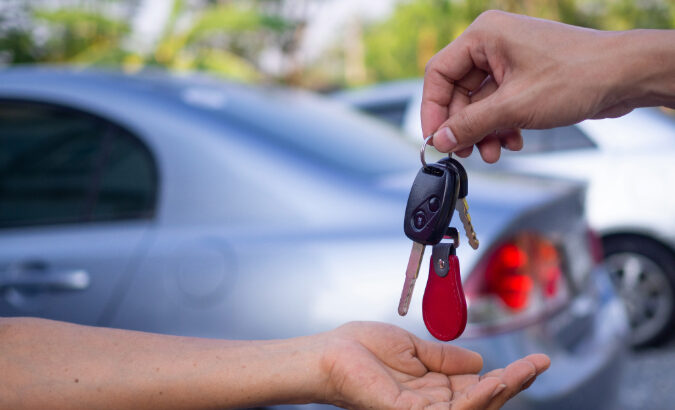
![New Technology in the Automotive Industry [Infographic]](https://blog.nationwide.com/wp-content/uploads/2017/03/Tech-Tricks-of-the-Future-Car.png)
Every automaker is somehow involved in the technology revolution that has redefined the primal relationship between car and driver over the last decade.
Future car technologies are touching nearly every area of a vehicle, from dashboard panels and passenger zones to the engine configuration, braking systems, headlights and even tires.
The cause of car innovations
What has been the driving force behind the future of cars? Two compelling forces: the call for ever greater safety, and a significant jump in minimum fuel economy standards set to take effect soon, pushing car makers to make vital changes to reach those limits.
Companies such as Seattle-based INRIX are working with major automakers to provide access to information that can help drivers get where they’re going or find what they’re looking for. This includes information such as real-time weather and road conditions, available parking spaces, gas station locations and pricing, traffic cameras, drive times and alternative routes in case of accidents or road construction.
But car innovations also result from consumer values, experts say. For example, blind-spot detection allows a car to “see” someone in the next lane via radar or camera technology and let the driver know when it’s safe to change lanes.
“What’s interesting is the consumer desire for these technologies,” says Kristin Kolodge, executive director of driver interaction and human machine interface with JD Power and Associates. She says that despite the extra costs involved, the future of cars is being driven by consumers who “are demonstrating the highest demand for those technologies.”
Measuring the surrounding environment
Still, some futuristic car technologies remain impractical because of the expense, prompting manufacturers to find more affordable options. For instance, the most advanced lane detection available uses light detection and ranging (Lidar), a 360-degree radar system that measures distance by bouncing laser light off surrounding objects. But the technology is prohibitively expensive. As a low-cost alternative, car makers can use multiple cameras placed around the car, alerting the computer to check lanes and potential dangers.
“Cars are looking at high-resolution webcams,” says Jeffrey Miller, an associate professor of engineering practice at the University of Southern California, whose research includes vehicle-to-vehicle communication. “They have 10 to 20 of these around a vehicle and piece all that data together so they have a picture of what’s going on around them.”
Communication between vehicles
With V2V communication, cars are able to “talk” via a 4G LTE wireless network to report traffic info and anticipate incidents that might otherwise lead to an accident. In the instance of two vehicles traveling together, the car in front could send back info on road conditions, such as icy patches, potholes or sharp curves. It could also send data instantly to the car behind when it hits the brakes.
“Cars are able to slow down a lot quicker,” says Miller. “Once the front vehicle slows down, the one behind it will brake within milliseconds.” A similar future car technology is adaptive cruise control, which automatically slows down the car to keep a safe distance from the vehicle in front.
Through vehicle-to-vehicle communication (V2V), drivers can alert one another to road hazards and conditions, changes in traffic and crashes almost instantaneously.
“Connected cars can share information on their speed and position at all times, as well as various actions that drivers take – such as making turns or abrupt stops,” explains Jordan Perch, a blogger at DMV. A relay of information gives other drivers an up-to-the-moment awareness of what’s happening with the vehicles that surround them on the road – and gives them a better chance to react more safely or avoid the situation entirely.
The ability to make such adjustments ahead of time rather than just in the nick of time not only contributes to the safety of everyone on the road, but also can have a direct economic effect. Drivers can avoid sitting in traffic, hard braking or rapid acceleration, all of which consume excess fuel.
The future of driving could involve this communication system being built into a city’s infrastructure, where traffic signs join the conversation and send data such as speed limits and stop signals to your vehicle.
Predictive vehicle technology
For now, the same wireless network that lets vehicles “talk” can turn your car’s interior into a mobile Wi-Fi hotspot, allowing passengers to stream music, watch movies or surf the Internet. Also, it lets your car send vital diagnostic information to the manufacturer, while receiving software updates in the same manner as your home computer.
Advances in car connectivity are leading to smart car technology that can link to your home and smartphone, allowing you to lock the car doors, start the engine or check a recent trip’s stats from the comfort of your couch. Cars in the future could take this a step further and learn your preferences and behavior patterns and set the interior temperature and seat position accordingly.
“It’s similar to what we’re seeing on consumer electronic devices or Internet searches that learn your behavior,” says Kolodge. For instance, if it’s Tuesday at 7 a.m., the car will know you’re heading to work and it could reroute your commute to avoid an accident. “Or it may know you have a calendar appointment and the time to arrive will put you past the meeting start time,” she adds. “So it might ask if you want to call the doctor’s office to let them know you’ll be 15 minutes late.”
Augmented reality dashboards
Besides Wi-Fi and other systems, the look of a car’s instruments and the way they display data is also changing. Augmented reality uses your windshield as a display screen to project information important to the driver, with heads-up displays (HUD) offering dashboard readouts such as speed, RPMs and gas mileage as well as weather reports and lane departure warnings. “It will display different symbols on your windshield regarding the road,” says Kolodge. “So if you need to make a right-hand turn in a quarter mile, it will overlay on the windshield a green arrow on the road.”
WayRay is developing a AR navigation system called Navion that will use holographic technology to display important information on the windshield rather than requiring the driver to take his or her eyes off the road to look at a touchscreen or dashboard.
What a car in the future could look like
The consequence of all these future car technologies should radically alter the interior of automobiles. The traditional dashboard and instrument displays may be replaced by projections on a window or linked to your smartphone, while front seats will no longer need to face forward.
“It’s going to be completely revolutionary,” says Miller. “You’re not going to have the frustrations of commuting in traffic every day.”
All these changes could drastically change the driving experience, but what about the automotive industry as a whole? Check out these emerging emerging trends in the automotive industry.



